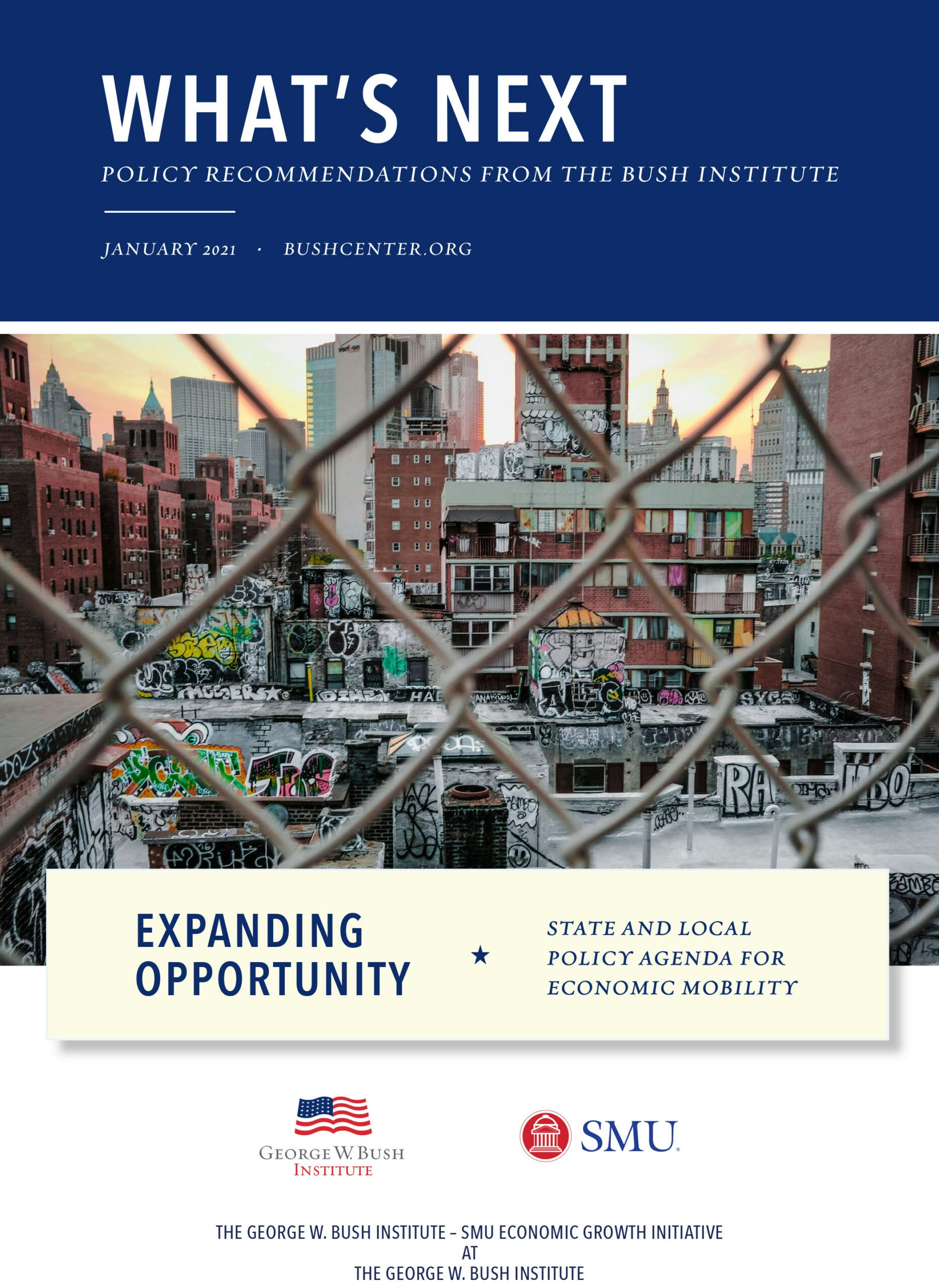Our Recommendations:
- Strengthen cities as quality-of-life centers where people will choose to live and work
- Plan for a more geographically decentralized and digitally connected model of work
- Build on the central role of ‘anchor institutions’
- Create new paths from education to the workforce
- Promote small business development
- Expand housing supply and affordability
- Promote homeownership and other avenues of wealth accumulation
Many of the largest obstacles to economic mobility arise from state and local policies, but a new opportunity agenda can play a vital role in creating more cities and towns of opportunity and renewing the American dream.
Growing concerns over the health of the American dream point to the need for new state and local policies to expand opportunity and economic mobility for as many Americans as possible. Cities have long been humankind’s greatest engines of upward mobility, and local realities powerfully influence young people’s educational and economic outcomes. But economic growth has left too many regions, cities, and neighborhoods – and the people living there – behind. Many left-behind places have large Black, Hispanic, or Native American communities. The COVID-19 crisis has laid bare these disparities.
Improving economic mobility should be a top-tier priority, for three reasons: Economic mobility is a key measure of how the nation is doing in increasing well-being; Helping as many Americans as possible fulfill their potential is crucial to growth and prosperity for everyone; and Americans won’t view our economic system as fair unless they believe hard-working, enterprising people have a good shot at getting ahead.
Median household income has grown more than 50% over the past four decades after inflation, taxes, and government transfers, and living standards have improved dramatically in ways that statistics don’t capture – such as medical progress, expanded leisure opportunities, and safer and more engaging work. But incomes after inflation have remained stagnant for Americans with only a high school diploma or less, amounting to approximately half the adult population. Racial income disparities remain as large as they were in the 1970s.
The costs of what most Americans view as necessities have grown faster than median incomes, contributing to the sense that millions of American families are falling behind. Spending on housing, education, healthcare, and transportation has increased to 56% of disposable income in 2019 from 47% in 2000, due mostly to rising housing prices but also to dysfunctions in the higher education and healthcare sectors. Median household wealth is lower than in 1969, and families in the bottom 40% by income collectively have negative net wealth, with debt exceeding financial assets. Negative savings rates among the bottom 40% are contributing to America’s troubling wealth trends, as are falling rates of business creation and declines in homeownership rates since the mid-2000s.
Several dozen leading cities are performing well as engines of opportunity, as the Bush Institute – SMU Economic Growth Initiative documents in a recent report. But most cities, towns, and rural areas are lagging far behind the leaders in educational outcomes, job-market access, business startups, and wealth-building opportunities. Meanwhile, some of America’s wealthiest cities have become unaffordable for most families, creating significant obstacles to economic mobility.
Strengthen cities as quality-of-life centers where people will choose to live and work
Highly skilled people in today’s knowledge-centric economy increasingly live where they want to live, and businesses follow. Localities must focus on creating attractive places to live and work for people of all education and skill levels. Public safety and good school choices are essential. Lifestyle amenities like greenspace, cultural institutions, and distinctive, walkable neighborhoods play a more important role than ever. Cities should work to retain homegrown, upwardly mobile people and to attract immigrants, in part because of their high rates of entrepreneurship and innovation-oriented activities. States and localities should maintain moderate business and personal tax burdens and reduce their reliance on tax incentives for business relocations. Studies by the Brookings Institution, the University of Toronto’s Martin Prosperity Institute, and others confirm these policies aren’t effective in promoting job creation, wage growth, or economic mobility. They should also rely more heavily on community benefits agreements with companies receiving public sector help, focusing primarily on workforce development.
Plan for a more geographically decentralized and digitally connected model of work
The COVID-19 crisis has accelerated long-term trends toward decentralized work models, including working from home and other remote locations. These trends will likely continue beyond the pandemic, and localities must reimagine physical spaces and expand digital infrastructure to thrive in the future. This means allowing a high degree of land-use flexibility to promote new roles for excess commercial real estate in core cities and new satellite workspaces in growing suburban communities. It also means permitting high labor-market flexibility and targeting large improvements in digital connectivity in underserved rural as well as metropolitan places.
Build on the central role of ‘anchor institutions’
Higher education and medical institutions – “eds and meds” – play an increasingly pivotal role in many cities, as the economy grows more knowledge-centric and demand for education and healthcare services rises. State and local authorities should invest in expanding the quality and capacity of public eds and meds institutions and step up support for basic research and innovation, as the Bush Institute – SMU Economic Growth Initiative argues in a report on the innovation and economic impact of knowledge-generating institutions. They should additionally broaden the mission of local institutions to become active leaders in economic mobility and racially equitable community development, expand operations at branch campuses in underserved areas, and prioritize process innovation to deliver services more cost effectively, incorporating pandemic lessons in remote learning and telemedicine.
Create new paths from education to the workforce
States and localities should promote economic mobility through more “early college” and career-oriented programs in high school that prepare students for further training and education; more high-quality and readily available college guidance; more opportunities for young people to earn degrees and other credentials in community colleges; better “handoffs” from community colleges to four-year institutions and workplace training programs; and more nationally consistent and transferable credentialing systems.
Promote small business development
States and localities should launch sweeping reforms to make it easier, faster, and cheaper to start a business. Priorities include reducing occupational licensing rules, making licenses transferable across state lines, eliminating “certificate-of-need” rules and other regulations that block entrants from regulated industries, and partnering with private and nonprofit sectors to promote business creation among people of color.
Expand housing supply and affordability
Numerous studies show that cities and towns with lighter-touch land-use rules experience greater housing supply growth, better affordability, lower housing segregation on income lines, and less displacement of lower-income residents than more restrictive places. Better functioning, more lightly regulated land-use markets are vital. States and cities should focus on repurposing underused land in core cities, expanding housing supply in high-growth suburban areas, and investing – with federal financial help – in innovative models to add affordable housing at scale. Cities should support “moves to opportunity,” but they can combat income-based segregation even more effectively at scale by fostering culturally diverse mixed-income, mixed-use neighborhoods in disadvantaged and underdeveloped areas. A new home-building boom can play a key role in fueling recovery from the COVID-19 recession.
Promote homeownership and other avenues of wealth accumulation
State and local public-private partnerships should launch initiatives to increase homeownership in disadvantaged communities through novel mechanisms like community land trusts and shared appreciation mortgages and to promote wealth accumulation through portable universal savings vehicles.
Many of the largest obstacles to economic mobility arise from state and local policies, but a new opportunity agenda can play a vital role in creating more cities and towns of opportunity and renewing the American dream.





























